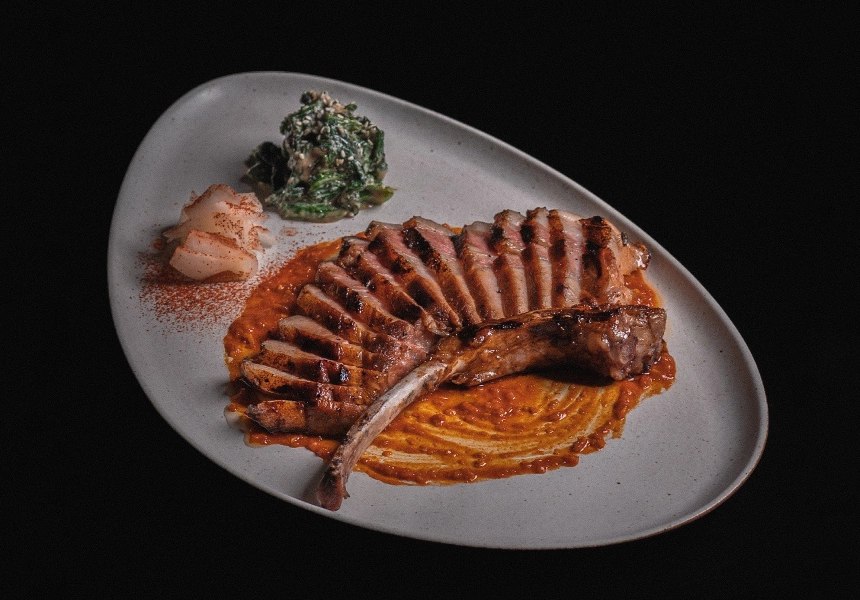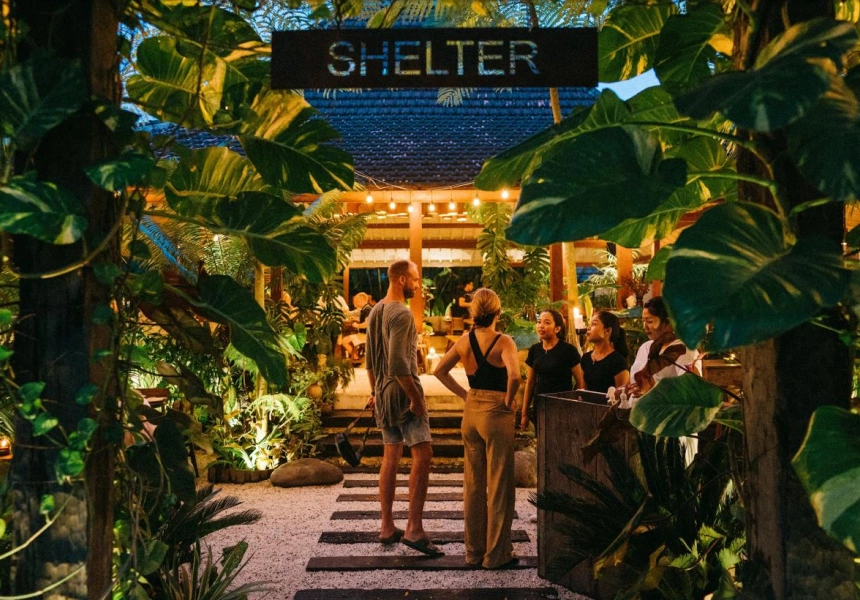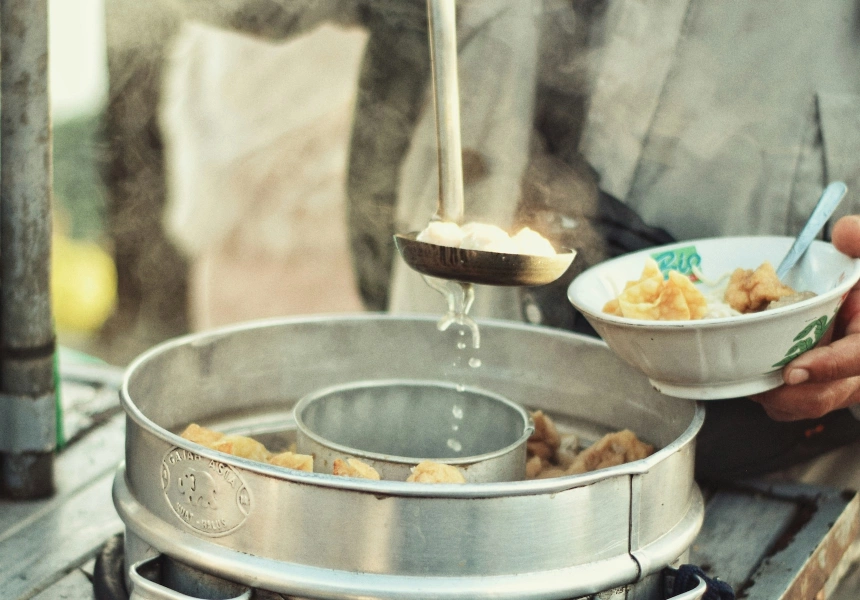It’s startling how quickly the scenery changes in Bali. One minute you’re on a street congested with boxy air-conditioned vans, battered motorbikes, ambling tourists and men wheeling food carts. The next, the concrete abruptly turns to nothing but serene rice paddies and vigorous jungle.
The capital, Denpasar, is a hectic city of almost 900,000 people. Urbanisation is tracking mostly westwards from here, taking advantage of the scenic coastline and its pretty sunsets. Kuta, Legian, Seminyak. You know these place names, even if you’ve never been to Bali. That’s because they’re the first three out of the airport.
This convenience means they’re also the most affected by tourism, the drunken Aussie lout kind especially. Travellers looking for a quieter or more cultural experience tend to head in any other direction, to rainforest town Ubud, emerging alternative Sidemen, neighbouring island Nusa Lembongan or the slower-paced beaches Sanur and Uluwatu.
But keep following that busy, tourist-packed coastline west and you reach the next in line: surfing hotspot Canggu (“chang-goo”). Development – gentrification might be a better word for it – has also asserted itself here, led mainly by Aussie chefs and restaurateurs.
Fashionable woodfired cooking and coastal chic interiors are abundant, and executed to the same high standard as in Australia’s capital cities. At times Canggu feels more like Byron Bay, Fitzroy or Surry Hills than Indonesia, with the Airbnb listings to match. While this familiarity is comforting, it does feel a bit antithetical to the idea of international travel. Don’t worry – you’ll likely make peace with it after a few days of eating like royalty, at about two-thirds the price you would in Australia. And the drunken louts? They haven’t moved in yet.
The best restaurants in Canggu
 Pork chop, pickled daikon, ssamjang and togarashi at Yuki. Photo: Courtesy of Yuki
Pork chop, pickled daikon, ssamjang and togarashi at Yuki. Photo: Courtesy of YukiUpstairs from tasteful beach club The Lawn and run by the same team, Skool is a handsome fire-powered restaurant in the mould of Sydney’s Ester, Adelaide’s Arkhe or Singapore’s Burnt Ends. Chefs bustle about the open kitchen, hearth flames leaping as they fire Wagyu rib eye, octopus with salsa verde, and Argentinian red prawns with smoked paprika butter. Despite the theatre, your eyes will be fixed elsewhere – Skool has some of Canggu’s best sunset views. And one of the area’s best wine lists.
An ulekan is a traditional Indonesian pestle used to grind spice pastes, and a fitting name for this schmick open-air restaurant from the same team behind the popular Milk & Madu cafes. Though it’s technically in Berawa, its fragrant beef cheek rendang, sates grilled over coffee-tree timber and barramundi cooked in banana leaves are well worth the brief Gojek (the local version of Uber) ride from Canggu. Finish with a local arrack (rice wine) and Beng-Beng cheesecake, inspired by the Indonesian chocolate bar of the same name.
Opened in 2021, this three-storey plant-filled greenhouse is surely one of Bali’s most attractive dining rooms. What’s going out on the plates is equally good, thanks to two Colombian-born chefs. Andres Becera was head honcho at Melbourne’s Movida and his mate German Rincon held the same position at Tetto di Carolina, also in M-town. Together they apply European fine-dining techniques to Latin American ingredients for creative dishes like mahi mahi tarama with cassava bread, woodfire squid with black garlic mole, and roasted lamb shoulder with tomatillo escabeche. Hot tip: the rooftop goes off around sunset.
Byron Bay-raised chef Ben Cross (ex-Rae’s on Wategos, Rockpool) drives this Mediterranean restaurant with locations in Canggu and Uluwatu. Its antipasto game is strong: mortadella, pastrami, salami, pickled veggies, dips and pates to hoe into before tackling mains. And wouldn’t you know it? Most of them are cooked over woodfire, from steaks and cumin-rubbed lamb shoulder to forearm-sized Papuan prawns and a spanakopita of house-made filo pastry. If your appetite for this sort of thing is inexhaustible, Smoke Bali is another good woodfire option nearby.
As we’ve established, Canggu is cool. And it doesn’t get any cooler than this airy boutique hotel, restaurant and bar, run by Ksubi co-founder George Gorrow and his wife Cisco Gorrow, a former model. With its gridded timber ceiling and exposed aggregate concrete floors, the dining room looks lifted from an interior design magazine. The menu, meanwhile, is an oddly cohesive mix of Japanese, Hawaiian, Indonesian and southern American food, where a cheeseburger sits alongside soy bean “hummus”, popcorn chicken dusted with togarashi spice mix, a poke bowl and chicken sates. Wear your best white linen outfit.
Scottish celebrity chef Will Meyrick has interests in Ubud and Seminyak, but for now this boundary-busting Chinese-Japanese restaurant stands alone in Canggu. It’s a place where n’duja and hazelnuts are paired with dry-aged tuna; where scallop and prawn dumplings get glazed with unagi (eel) soy sauce; and karaage chicken “lollipops” come with dried-shrimp sambal. Shrug off your preconceptions and lean into the fusion – preferably with a Beeswax Negroni or Peanut Butter Old Fashioned in hand.
If you’re after a more familiar take on Japanese food, you’ll find it at this beachfront izakaya, alongside a few populist hits like nori ahi “tacos” and truffled tuna rolls. For the most part, though, it’s about charcoal delights: yakitori chicken, salty-sweet glazed mushrooms, line-caught fish of the day, king prawns and more. Founder Rai Sutama was raised between Bali and Melbourne, where he worked at Crown Casino’s exclusive Mahogany Room, among other places. The extremely open-air design speaks to his heritage by way of rattan, coffee-tree timber accents and local Kerobokan stone floors.
Independent breweries aren’t yet plentiful in Bali, in part due to Bintang’s stranglehold. Founded by Italian surfer Mattia Morri, Island Brewing and aficionado sub-brand Black Sand are notable exceptions. Visit this brick warehouse for crushable mid-strength lager, a salted-lime sour, trendy hazy IPAs and more. It’s also a great place for a casual feed, in the form of fried-chicken sangas, salumi platters, tuna ceviche and various pizzettas.
The best restaurants in Pererenan
 The entrance to Shelter. Photo: Courtesy of Shelter
The entrance to Shelter. Photo: Courtesy of ShelterGive it five years and people will be talking about Pererenan the same way as neighbouring Canggu. The quiet locale is mostly houses and empty blocks, but it won’t be for long.
Shelter is a bellwether, packed every night of the week with people seeking thrilling Middle Eastern dishes by chef and co-owner Stephen Moore (ex-Rockpool and the Bridge Room. A sample: warm za’atar pretzel with house-made labne, barbequed octopus and whipped potato tortilla, edamame falafel with tabouleh, and a main of chermoula-crusted chicken with burnt lemon. The menu is long and necessitates hard decisions, which is maybe a reason people keep coming back. Ditto for the 80-bottle wine list packed with aromatic whites and fresh rosés.
Chef and cookbook author Wayan Kresna Yasa was raised on the small island of Nusa Penida and went on to work in some of the world’s best kitchens: Blue Hill at Stone Barns in New York and Acadia in Chicago. Now he’s on a mission to share Balinese food with a wider audience. At Home that includes lumpia (spring rolls), tipat cantok (rice cake salad) and ayam betutu (spiced chicken), sometimes jazzed up with the odd Mesoamerican ingredients, like quinoa or chayote (choko). Despite the chef’s high-end credentials, this is a modest, welcoming place.
Vera, from Ben Cross and the Mason team, bills itself as a “new generation Parisian bistro”. That sounds absurd, until you imagine it transplanted to the French capital, albeit with extra walls. Yep, checks out. There are farm-fresh crudites and dainty tartlets to start, then it’s onto 12-month comte risotto, pumpkin pithivier and Australian O’Connor Beef steaks, all plated in a beautifully minimalist style. The smartly aproned staff have the wines to match, plus Corpse Revivers, Martinis and other staunch cocktails.
Essential warung and street foods
 A street vendor ladles hot bakso into a bowl. Photo: Courtesy of Unsplash / Azzadiva Sawungrana
A street vendor ladles hot bakso into a bowl. Photo: Courtesy of Unsplash / Azzadiva SawungranaFor real this time: it’d be a shame to travel to Bali and only eat at restaurants run by Australians, for Australians. The island has its own rich food culture, distinct from the rest of Indonesia’s. Even in the most affluent areas, brightly painted and supremely affordable food carts towed by bike, motorbike or human are a constant presence, ringing their bells to attract customers. Their operators may not speak English, but get over this little hurdle and the rewards are plentiful. Yes, Bali belly is a slight possibility, but choose wisely and you should be fine.
Babi guling
Indonesia is a Muslim-majority country, so pork is off the menu in most of the country. It’s a different story in Hindu Bali, where spit-roasted suckling pig is advertised everywhere. Look for specialist warungs such as Babi Guling Swari, Babi Guling Men Lari and Warung Tania Babi Guling, all in Canggu.
Bakso
These dense beef (or another protein) meatballs in hot broth are super easy to find – just look for the carts with the word “bakso” on them. The plain version is known as sup bakso, while mie bakso adds vermicelli or other noodles. Add kecap manis (sweet soy sauce) or spicy sambal to your liking.
Sate lilit
You’re probably familiar with satays/sates, or skewered meats grilled over ferociously hot coals. Sate lilit is that, except the protein is first minced and combined with grated coconut, lime leaves and spices to form an elongated meatball of ayam (chicken), babi (pork), sapi (beef) or ikan (fish). Order by the dozen.
Tipat cantok
Typically served on a square of greaseproof paper, this salad-adjacent dish is a jumble of steamed beansprouts, water spinach or other veggies, and tipat, or compressed white rice cakes cooked in a pouch of woven palm leaves. What makes it sing is a generous pour of satay-style peanut sauce over the top, sometimes spicy, sometimes not. Tipat tahu is the same dish but adds golden-brown, pan-fried tofu to the jumble.
Lawar
Green beans, lime leaves, grated coconut, coconut milk, eggs, shallots, herbs and some form of mincemeat and/or jackfruit are the typical ingredients in this stir-fry popular all over the island. Sometimes it contains chicken or pork blood to add extra richness (lawar merah, or “red”). Look for lawar putih (“white”) if you’d prefer no blood.
Nasi jinggo
This handheld meal package is possibly the most street food of all the street foods. It consists of a literal handful of white rice, plus side dishes and condiments, all wrapped up in a banana leaf and ready to eat on the go. Expect tempeh, dried anchovies, sauteed coconut, sambal and more.
Martabak
Popular just about everywhere Muslim people have traded or colonised in Southeast Asia, these thick, pillowy crepes come savoury or sweet. In the former guise they might be folded over eggs, minced meat, chives or spring onion. In the latter, peanut butter, melted chocolate or sweetened banana.
This story is part of The Travel Issue: Wish You Were Here.


























